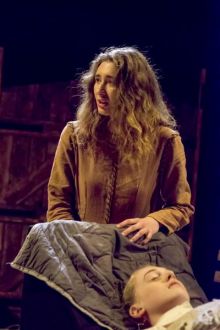The Crucible
The University Of Adelaide Theatre Guild’s latest production brings a visceral intensity to a very familiar and oft-revived play, that has become such a frequent staple of high school English classes it’s likely to have lost some of its edge to many seasoned theatregoers. This staging of The Crucible places a strong emphasis on the more timeless themes inherent in Arthur Miller’s work – such as religious intolerance, the politics of fear and manipulation of identity – that are still relevant to today’s world, resulting in a performance that feels fresh and immediate, despite how venerable the text is. The contemporary energy that is brought to the stage does much to compensate for some questionable casting choices and directorial gimmicks.

The cast are inconsistent when it comes to accents. Most of the actors play the parts with their natural Australian accents, or a “neutral British” sound. But several of the performers attempt something different and it comes across as oddly affected. This is especially noticeable in the performances of Cheryl Douglas and Ben Todd.
Douglas plays the role of Elizabeth Proctor with a gritty, fierce determination – but her bizarre cockney inflections detract from the intensity of her delivery, and seem weirdly out of place when she is engaged in dialogue with actors who are speaking naturally.
For no readily apparent reason, Ben Todd plays Reverend Hale with a very broad, and oddly inconsistent Scots-Irish accent. Todd’s performance isn’t helped by an unconvincing wig, which sometimes obscures the nuances of his facial expressions. Hale’s emotional journey from fanaticism to doubt is one of the more interesting dramatic arcs in Miller’s play and it’s buried under pointless affectations here.

Kim Clark is suitably anguished as flawed hero John Proctor, conveying both the character’s guilt and idealism with deep poignancy. However, he is perhaps too old for the part and the scenes which call for sexual tension between John and teenage antagonist Abigail (Zoe Dibb) are oddly unconvincing. The required sparks don’t fly between the two… which is a pity, because Dibb’s performance is otherwise faultless. She effectively embodies the duality of a character who is both menacing and pitiful, both a victim and a victimiser.
Abigail’s child accomplices are played with impressive physicality and sometimes frightful vehemence by Gabi Douglas, Kelsey Lampard, Ashley Penny and Zoe Muller. Their wild histrionics in the courtroom are so convincingly hysterical it’s not hard to see why educated men would assume that possession was the most likely explanation. David Haviland, Alex King, Philip Lineton, John Sabine, Rhoda Sylvester and Deborah Walsh all have striking moments in smaller roles as townsfolk caught up in the escalating paranoia of the Witch Hunts.
But the standout performances come from Steve Marvanek as Judge Danforth and Chris Leech as Reverend Parris. Both actors think outside the square in their interpretation of the characters and the results are fascinating. Parris is typically depicted as an ineffectual weakling, but Leech plays him as a charismatic, “fire and brimstone” preacher, bringing an unexpectedly menacing edge to the part. The character of Danforth is typically portrayed as a stoic, cool-ly calculating authority figure but Marvanek portrays him as flustered and uncertain of his power, frightened by both the proceedings and the ripple effect they are having upon society. These two master thespians succeed in taking two iconic characters and truly making them their own.

Production values throughout are quite high, with the sets, props and costumes all having an authentic period feel. For the most part, Geoff Brittain’s direction makes sense, but the opening scene is in questionable taste. The director has chosen to begin The Crucible by staging a scene that isn’t actually in Miller’s original script for the play, though it did serve as the opening for the 1996 movie version. A group of girls meet to dance in the woods and one of them strips naked (the actress wearing a body stocking). Originally, this event was simply referred to after-the-fact in dialogue by the other characters, who argue about the details of what actually happened. Brittain’s staging is well acted and visually exciting – but by explicitly dramatizing this scene, he destroys the ambiguity of subsequent dialogue in which the characters give conflicting testimonies. It also means that the characters spend some time repeating things that the audience already knows.
Still, all things considered, this production of “The Crucible” does more right than wrong and it’s never dull. That in itself is really quite an achievement, given the familiarity of the material.
Benjamin Orchard
Subscribe to our E-Newsletter, buy our latest print edition or find a Performing Arts book at Book Nook.

